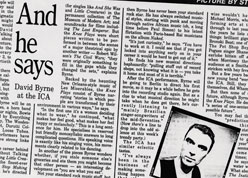ORIGINAL
PRESS CLIPPINGS

Maximum Art in Minimalist Plays
Hope? Enlightenment? Multi-national, multi-generational transformation? You pays your money, you takes your chance.
Even "the Knee Plays" have "knee plays." During the set-ups for the 13 segments, the dancers periodically emerge to engage in various floor exercises, all choreographed engagingly by Suzushi Hanayagi, usually to sounds suggesting industrial tasks.
Throughout all the digressions and segments, the David Byrne score — sometime on tape, but mostly live, interpreted by the excellent Les Misérables Brass Band […] lists of things in the future.
The fact that, for the most part, this narration seems to have little or nothing to do with what's happening onstage helps create a most interesting esthetic tension.
Byrne's fascinating score itself rests on languid but curiously insistent chordal cadences — a kind of urban jazz-chant — with heavy brass being the perfect form for its delivery.
Ultimately, even with its slower sections and built-in vagueness, these "knee plays" whet the appetite to see the entire Wilson opera, someday, somewhere, even at the risk of occasional irritation at his slow pacing. (At 95 minutes, "the Knee Plays" is a kind of Wilson lark.) To date, segments have been performed in Rotterdam, Rome, Minneapolis and Cologne. The Cologne segment also was done in Cambridge, Mass., last year, which led to Wilson's Pulitzer Prize nomination.
Wilson, working on the scale that he does and with concepts of his own devising, has forever altered the way the modern world perceives its theater, opera, dance and performance art. Here, in Berkeley, for two nights only, audiences are being given an opportunity to gain an insight, however minimal, into this major artist's unique esthetic.